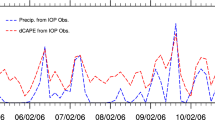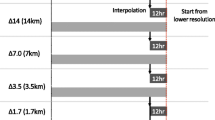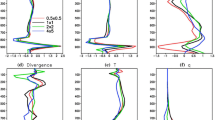Abstract
Convection-resolving models (CRMs) can explicitly simulate deep convection and resolve interactions between convective updrafts. They are thus increasingly used in numerous weather and climate applications. However, the truncation of the continuous energy cascade at scales of \(\mathcal {O}\)(1 km) poses a serious challenge, as in kilometer-scale simulations the size and properties of the simulated convective cells are often determined by the horizontal grid spacing (\(\Delta x\)).In this study, idealized simulations of deep moist convection over land are performed to assess the convergence behavior of a CRM at \(\Delta x =\) 8, 4, 2, 1 km and 500 m. Two types of convergence estimates are investigated: bulk convergence addressing domain-averaged and integrated variables related to the water and energy budgets, and structural convergence addressing the statistics and scales of individual clouds and updrafts. Results show that bulk convergence generally begins at \(\Delta x =4\) km, while structural convergence is not yet fully achieved at the kilometer scale, despite some evidence that the resolution sensitivity of updraft velocities and convective mass fluxes decreases at finer resolution. In particular, at finer grid spacings the maximum updraft velocity generally increases, and the size of the smallest clouds is mostly determined by \(\Delta x\). A number of different experiments are conducted, and it is found that the presence of orography and environmental vertical wind shear yields more energetic structures at scales much larger than \(\Delta x\), sometimes reducing the resolution sensitivity. Overall the results lend support to the use of kilometer-scale resolutions in CRMs, despite the inability of these models to fully resolve the associated cloud field.















Similar content being viewed by others
References
Baldauf M, Seifert A, Förstner J, Majewski D, Raschendorfer M, Reinhardt T (2011) Operational convective-scale numerical weather prediction with the cosmo model: description and sensitivities. Mon Weather Rev 139(12):3887–3905
Ban N, Schmidli J, Schär C (2014) Evaluation of the convection-resolving regional climate modeling approach in decade-long simulations. J Geophys Res Atmos 119(13):7889–7907
Banta RM (1984) Daytime boundary-layer evolution over mountainous terrain. Part I: Observations of the dry circulations. Mon Weather Rev 112(2):340–356
Banta RM (1990) The role of mountain flows in making clouds. Atmos Proc Over Complex Terrain Meteorol Monogr 23(45):229–282
Barthlott C, Burton R, Kirshbaum D, Hanley K, Richard E, Chaboureau JP, Trentmann J, Kern B, Bauer HS, Schwitalla T et al (2011) Initiation of deep convection at marginal instability in an ensemble of mesoscale models: a case-study from cops. Q J R Meteorol Soc 137(S1):118–136
Blackadar AK (1962) The vertical distribution of wind and turbulent exchange in a neutral atmosphere. J Geophys Res 67(8):3095–3102
Böing SJ, Jonker HJ, Siebesma AP, Grabowski WW (2012) Influence of the subcloud layer on the development of a deep convective ensemble. J Atmos Sci 69(9):2682–2698
Bott A (1989) A positive definite advection scheme obtained by nonlinear renormalization of the advective fluxes. Mon Weather Rev 117(5):1006–1016
Brockhaus P, Lüthi D, Schär C (2008) Aspects of the diurnal cycle in a regional climate model. Meteorol Zeit 17(4):433–443
Brousseau P, Seity Y, Ricard D, Léger J (2016) Improvement of the forecast of convective activity from the arome-france system. Q J R Meteorol Soc 142(699):2231–2243
Bryan GH, Morrison H (2012) Sensitivity of a simulated squall line to horizontal resolution and parameterization of microphysics. Mon Weather Rev 140(1):202–225
Bryan GH, Wyngaard JC, Fritsch JM (2003) Resolution requirements for the simulation of deep moist convection. Mon Weather Rev 131(10):2394–2416
Craig GC, Dörnbrack A (2008) Entrainment in cumulus clouds: what resolution is cloud-resolving? J Atmos Sci 65(12):3978–3988
Dai A, Trenberth KE (2004) The diurnal cycle and its depiction in the Community Climate System Model. J Clim 17(5):930–951
Dauhut T, Chaboureau JP, Escobar J, Mascart P (2015) Large-eddy simulations of hector the convector making the stratosphere wetter. Atmos Sci Lett 16(2):135–140
Done J, Davis CA, Weisman M (2004) The next generation of NWP: explicit forecasts of convection using the Weather Research and Forecasting (WRF) model. Atmos Sci Lett 5(6):110–117
Frei C, Schär C (1998) A precipitation climatology of the alps from high-resolution rain-gauge observations. Int J Climatol 18(8):873–900
Grabowski WW (2001) Coupling cloud processes with the large-scale dynamics using the cloud-resolving convection parameterization (crcp). J Atmos Sci 58(9):978–997
Grabowski W, Bechtold P, Cheng A, Forbes R, Halliwell C, Khairoutdinov M, Lang S, Nasuno T, Petch J, Tao WK et al (2006) Daytime convective development over land: a model intercomparison based on LBA observations. Q J R Meteorol Soc 132(615):317–344
Hanley KE, Plant RS, Stein TH, Hogan RJ, Nicol JC, Lean HW, Halliwell C, Clark PA (2015) Mixing-length controls on high-resolution simulations of convective storms. Q J R Meteorol Soc 141(686):272–284
Hassanzadeh H, Schmidli J, Langhans W, Schlemmer L, Schär C (2015) Impact of topography on the diurnal cycle of summertime moist convection in idealized simulations. Meteorol Zeit
Heise E, Lange M, Ritter B, Schrodin R (2003) Improvement and validation of the multi-layer soil model. COSMO Newsl 3:198–203
Hohenegger C, Brockhaus P, Schär C (2008) Towards climate simulations at cloud-resolving scales. Meteorol Zeit 17(4):383–394
Hohenegger C, Schlemmer L, Silvers L (2015) Coupling of convection and circulation at various resolutions. Tellus A 67:26678
Houze R (1993) Cloud dynamics. Academic, San Diego
Kendon EJ, Roberts NM, Senior CA, Roberts MJ (2012) Realism of rainfall in a very high-resolution regional climate model. J Clim 25(17):5791–5806
Khairoutdinov M, Randall D (2006) High-resolution simulation of shallow-to-deep convection transition over land. J Atmos Sci 63(12):3421–3436
Kirshbaum DJ (2011) Cloud-resolving simulations of deep convection over a heated mountain. J Atmos Sci 68(2):361–378
Kirshbaum D, Grant A (2012) Invigoration of cumulus cloud fields by mesoscale ascent. Q J R Meteorol Soc 138(669):2136–2150
Klemp JB, Wilhelmson RB (1978) The simulation of three-dimensional convective storm dynamics. J Atmos Sci 35(6):1070–1096
Langhans W, Fuhrer O, Schmidli J (2012a) Description and application of a budget-diagnosis tool in COSMO. COSMO Newsl 12:43–51
Langhans W, Fuhrer O, Schmidli J (2012b) Description and application of a budget-diagnosis tool in COSMO. COSMO Newsl 12:43–51
Langhans W, Schmidli J, Schär C (2012c) Bulk convergence of cloud-resolving simulations of moist convection over complex terrain. J Atmos Sci 69(7):2207–2228
Lapillonne X, Fuhrer O, Spörri P, Osuna C, Walser A, Arteaga A, Gysi T, Rüdisühli S, Osterried K, Schulthess T (2016) Operational numerical weather prediction on a gpu-accelerated cluster supercomputer. EGU Gen Assembly Conf Abstr 18:13554
Lean HW, Clark PA, Dixon M, Roberts NM, Fitch A, Forbes R, Halliwell C (2008) Characteristics of high-resolution versions of the Met Office Unified Model for forecasting convection over the United Kingdom. Mon Weather Rev 136(9):3408–3424
Leuenberger D, Koller M, Fuhrer O, Schär C (2010) A generalization of the SLEVE vertical coordinate. Mon Weather Rev 138(9):3683–3689
Leutwyler D, Fuhrer O, Lapillonne X, Lüthi D, Schär C (2016) Towards european-scale convection-resolving climate simulations with GPUS: a study with cosmo 419. Geosci Modell Dev 9(9):3393
Leutwyler D, Lüthi D, Ban N, Fuhrer O, Schär C (2017) Evaluation of the convection-resolving climate modeling approach on continental scales. J Geophys Res Atmos 122(10):5237–5258
Louis JF (1979) A parametric model of vertical eddy fluxes in the atmosphere. Bound Layer Meteorol 17(2):187–202
Ludlam FH (1980) Clouds and storms: the behavior and effect of water in the atmosphere. Pennsylvania State University Press, Pennsylvania
Mellor GL, Yamada T (1974) A hierarchy of turbulence closure models for planetary boundary layers. J Atmos Sci 31(7):1791–1806
Mellor GL, Yamada T (1982) Development of a turbulence closure model for geophysical fluid problems. Rev Geophys 20(4):851–875
Panosetti D, Böing S, Schlemmer L, Schmidli J (2016) Idealized large-eddy and convection-resolving simulations of moist convection over mountainous terrain. J Atmos Sci 73(10):4021–4041
Pope SB (2000) Turbulent flows. Cambridge University Press, Cambrigde
Prein AF, Langhans W, Fosser G, Ferrone A, Ban N, Goergen K, Keller M, Tölle M, Gutjahr O, Feser F et al (2015) A review on regional convection-permitting climate modeling: demonstrations, prospects, and challenges. Rev Geophys 53(2):323–361
Prein AF, Rasmussen RM, Ikeda K, Liu C, Clark MP, Holland GJ (2017) The future intensification of hourly precipitation extremes. Nat Clim Chang 7(1):48–52
Randall D, Khairoutdinov M, Arakawa A, Grabowski W (2003) Breaking the cloud parameterization deadlock. Bull Am Meteorol Soc 84(11):1547–1564
Raschendorfer M (2001) The new turbulence parameterization of LM. COSMO Newsl 1:89–97
Reinhardt T, Seifert A (2006) A three-category ice scheme for LMK. COSMO Newsl 6:115–120
Ricard D, Lac C, Riette S, Legrand R, Mary A (2013) Kinetic energy spectra characteristics of two convection-permitting limited-area models arome and meso-nh. Q J R Meteorol Soc 139(674):1327–1341
Ritter B, Geleyn JF (1992) A comprehensive radiation scheme for numerical weather prediction models with potential applications in climate simulations. Mon Weather Rev 120(2):303–325
Rockel B, Will A, Hense A (2008) The Regional Climate Model COSMO-CLM (CCLM). Meteorol Zeit 17(4):347–348
Schär C, Leuenberger D, Fuhrer O, Lüthi D, Girard C (2002) A new terrain-following vertical coordinate formulation for atmospheric prediction models. Mon Weather Rev 130(10):2459–2480
Schlemmer L, Hohenegger C (2014) The formation of wider and deeper clouds as a result of cold-pool dynamics. J Atmos Sci 71(8):2842–2858
Schlemmer L, Hohenegger C, Schmidli J, Bretherton CS, Schär C (2011) An idealized cloud-resolving framework for the study of midlatitude diurnal convection over land. J Atmos Sci 68(5):1041–1057
Schwartz CS, Kain JS, Weiss SJ, Xue M, Bright DR, Kong F, Thomas KW, Levit JJ, Coniglio MC (2009) Next-day convection-allowing WRF model guidance: a second look at 2-km versus 4-km grid spacing. Mon Weather Rev 137(10):3351–3372
Tang Y, Lean HW, Bornemann J (2013) The benefits of the met office variable resolution NWP model for forecasting convection. Meteorol Appl 20(4):417–426
Verrelle A, Ricard D, Lac C (2015) Sensitivity of high-resolution idealized simulations of thunderstorms to horizontal resolution and turbulence parametrization. Q J R Meteorol Soc 141(687):433–448
Weisman ML, Klemp JB (1982) The dependence of numerically simulated convective storms on vertical wind shear and buoyancy. Mont Weather Rev 110(6):504–520
Weisman ML, Skamarock WC, Klemp JB (1997) The resolution dependence of explicitly modeled convective systems. Mon Weather Rev 125(4):527–548
Weisman ML, Davis C, Wang W, Manning KW, Klemp JB (2008) Experiences with 0–36-h explicit convective forecasts with the wrf-arw model. Weather Forecast 23(3):407–437
Wicker LJ, Skamarock WC (2002) Time-splitting methods for elastic models using forward time schemes. Mon Weather Rev 130(8):2088–2097
Wyngaard JC (2004) Toward numerical modeling in the terra incognita. J Atmos Sci 61(14):1816–1826
Zhou B, Simon JS, Chow FK (2014) The convective boundary layer in the terra incognita. J Atmos Sci 71(7):2545–2563
Acknowledgements
Funding for all the authors was provided by the Swiss Federal Institute of Technology, Zurich (ETH Zurich) and the Center for Climate Systems Modeling (C2SM) through the convection-resolving climate modeling on future supercomputing platforms (crCLIM) project. The numerical simulations have been performed on the Cray XC30 (Piz Daint) at the Swiss National Supercomputing Centre (CSCS). The authors acknowledge PRACE for awarding access to Piz Daint at CSCS. Access to the COSMO-Model was kindly provided by the Consortium for Small-Scale Modeling. The authors thank Daniel Lüthi for the technical support and Wolfgang Langhans for the helpful discussions. The authors are also thankful to two anonymous reviewers for their valuable comments and recommendations.
Author information
Authors and Affiliations
Corresponding author
Additional information
This paper is a contribution to the special issue on Advances in Convection-Permitting Climate Modeling, consisting of papers that focus on the evaluation, climate change assessment, and feedback processes in kilometer-scale simulations and observations. The special issue is coordinated by Christopher L. Castro, Justin R. Minder, and Andreas F. Prein.
Rights and permissions
About this article
Cite this article
Panosetti, D., Schlemmer, L. & Schär, C. Convergence behavior of idealized convection-resolving simulations of summertime deep moist convection over land. Clim Dyn 55, 215–234 (2020). https://doi.org/10.1007/s00382-018-4229-9
Received:
Accepted:
Published:
Issue Date:
DOI: https://doi.org/10.1007/s00382-018-4229-9




